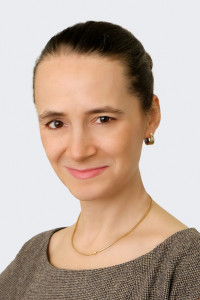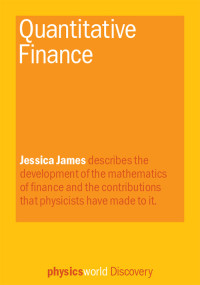
Mixing physics and finance – Jessica James is the author of the new Physics World Discovery ebook Quantitative Finance.
By Matin Durrani
Among the many joys of studying physics is that a degree in the subject can take you down lots of different paths. As our recent Physics World Careers 2017 guide revealed, they range from research and industry to education, IT and even sports, politics and the arts.
One particularly popular destination is the world of finance, which is hardly surprising given physicists’ love of numbers. Those in finance work in many different areas, with one of the most high profile – and lucrative – being the field of “quantitative finance”.
But what exactly does the term mean and what’s the field all about? To find out more, do check out the new, free-to-read Physics World Discovery ebook entitled Quantitative Finance, written by Jessica James – a managing director and senior quantitative researcher at Commerzbank in London.
As James explains in the introduction to her book, the field includes “complex models and calculations that value financial contracts, particularly those which reference events in the future, and applies probabilities to these events”. I encourage you to read her book, which is available in PDF, ePub and Kindle formats. And to whet your appetite, James has kindly answered some questions about what she does, her career to date and what the book’s about.
How did your career take you from physics into finance?
I never thought of going into finance. A letter landed on my supervisor’s desk from the First National Bank of Chicago (FNBC). It was addressed to “The Head of the Physics Department, University of Oxford, Oxford”. No-one really had that title but it ended up on his desk. He tossed it over to me one day when I was trying to write up my thesis. FNBC wanted to find folk who could do mathematics to value complex financial contracts, and thought that an Oxford PhD physicist might be a good choice. In those days (1994) it was not a normal career path!
 So what do you do in your current job at Commerzbank?
So what do you do in your current job at Commerzbank?
I’m in the research team. I cover interest rates and foreign exchange. I work out why they behave as they do and hopefully manage to predict their future activity. One can certainly gain a statistical edge but saying what will happen tomorrow is a challenging task!
What are the benefits of working in the financial world?
It’s great fun and fast moving. It’s a new and ever-changing field. I’ve travelled, worked in many different areas and with many different people. I’m never bored!
And what about the downsides?
It’s highly dependent on the markets, so often not very stable, and can be high-stress.
In your Physics World Discovery ebook you look in particular at negative interest rates and anomalies in the foreign-exchange market – can you say briefly why you decided to look at those two areas?
They are “interesting”! Negative interest rates were never supposed to occur and broke many of the models used to value interest rate products. The quants who devise the models had to revise many of them in record time. And the anomalies work is very close to my heart. Too often in finance the focus is on “now” and “tomorrow” when there is so much we can learn from historical data. I showed, using easily available data, that foreign exchange options, which are a 300 billion USD per day market, have been misvalued since the start of the market in the 1980s. It’s a statistical anomaly rather than a risk-free trade but it means that folk were buying and selling these products with very wrong ideas of their eventual value. I eventually wrote a book about it when it became clear it was important.
• For more Physics World Discovery ebooks, visit physicsworlddiscovery.org.
Guidelines
Show/hide formatting guidelines
this text was deletedwhere people live in harmony with nature and animals</q>
Some text